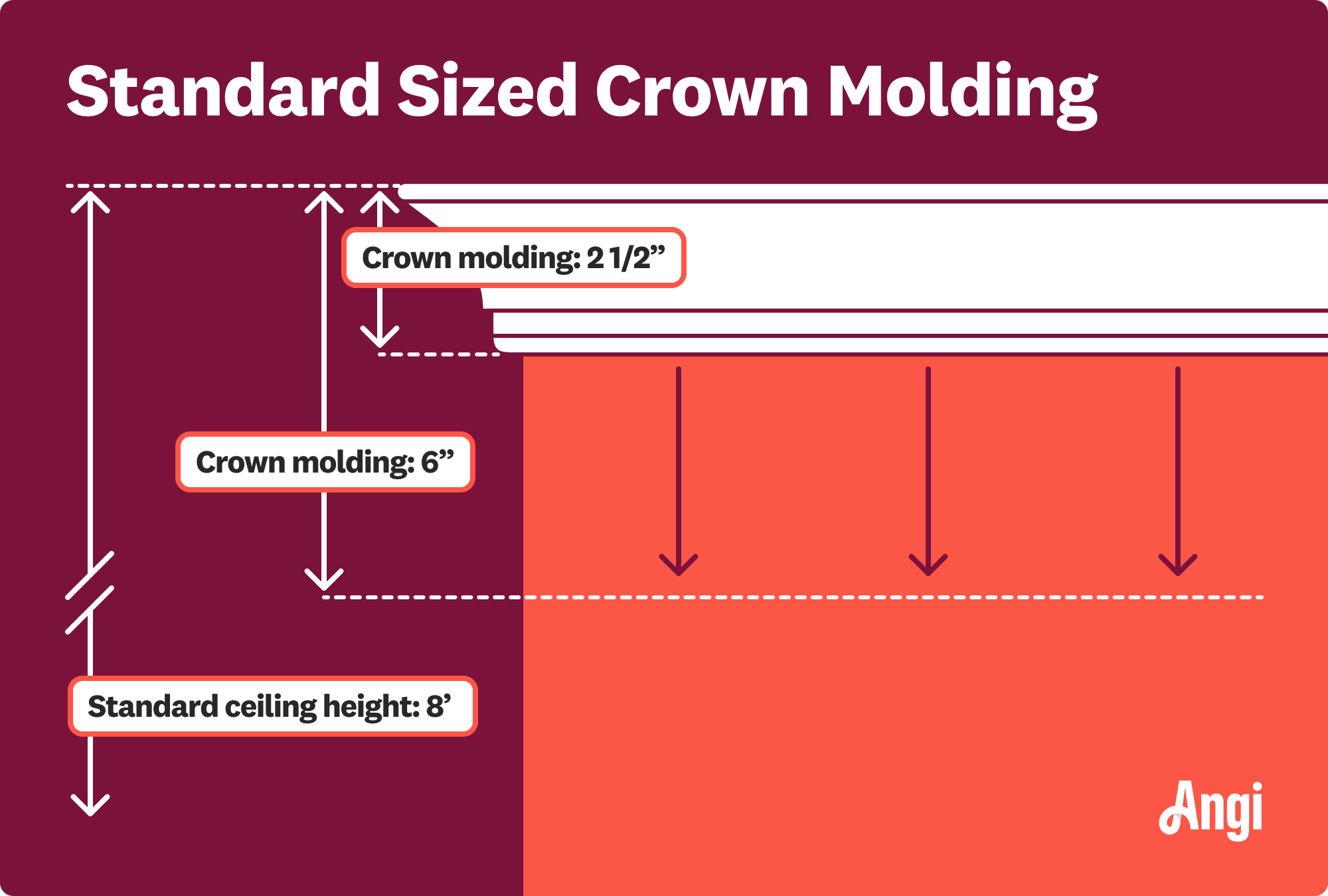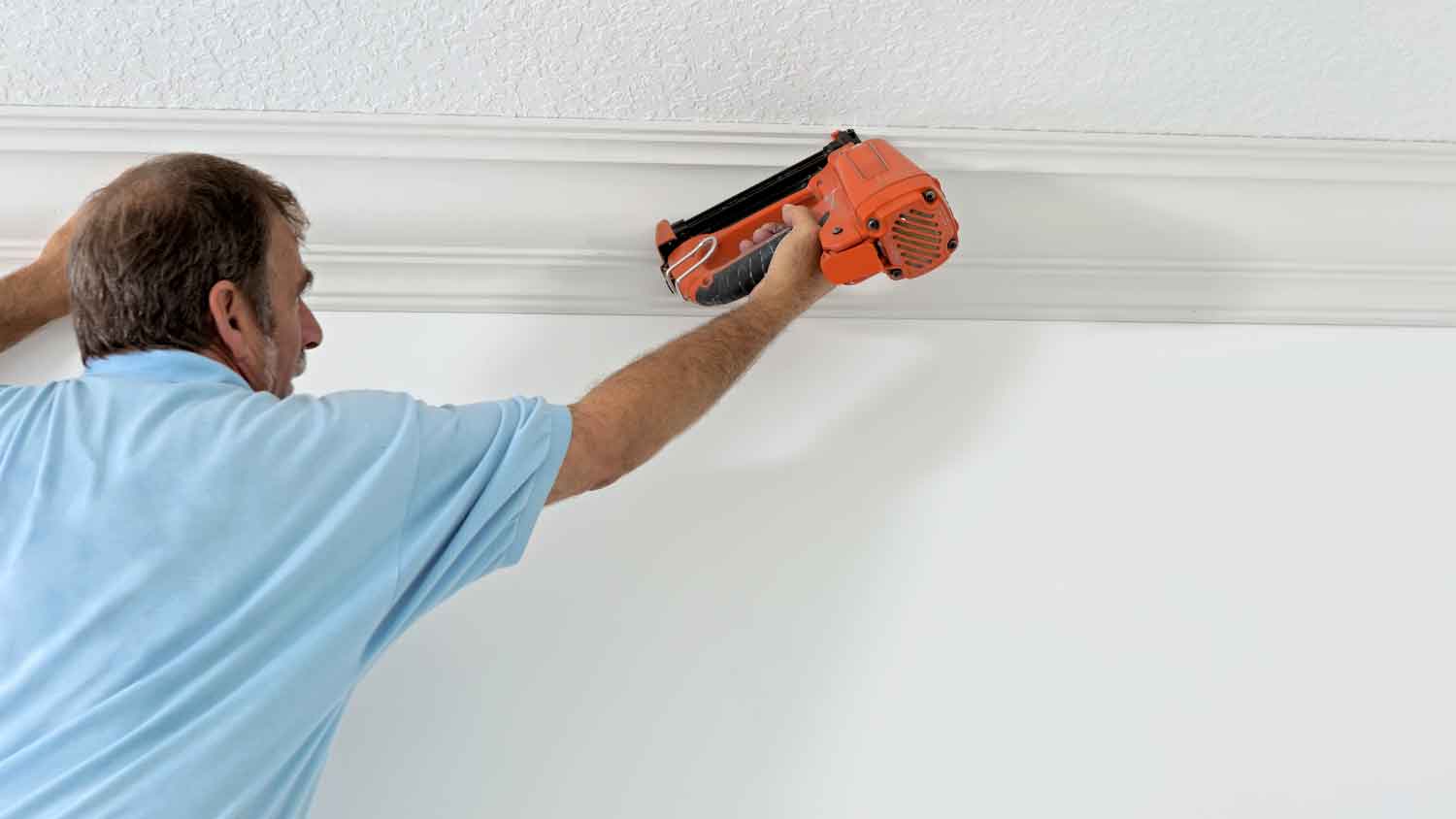The Best Crown Molding Sizes for Your Home
How tall is too tall for this eye-catching trim?


Crown molding for standard ceilings is 2 1/2 to 6 inches tall.
Taller ceilings can accommodate 4 to 24 inches of molding.
Crown molding is 1 inch shorter than the baseboards.
Taller molding is more common in formal rooms.
There’s no way around it—crown molding adds character to a room. In fact, there are so many different styles that it can suit just about any home, from modern or contemporary to Victorian, art deco, Georgian, and just about anything else. The key is choosing the proper size along with the right detailing. This guide covers the ideal crown molding sizes for your space.
What Are Standard Crown Molding Sizes?

Though there aren’t standard crown molding sizes, most crown molding has a height between 3 and 12 inches, though it can be even higher. For standard-height ceilings, you’ll want crown molding that’s 2 1/2 to 6 inches tall. Rooms with higher ceilings should have larger crown molding and rooms with standard-height ceilings should have a smaller crown molding.
These proportions relate back to the orders of classic architecture. Crown molding is an exceptionally old art form with roots in some of the earliest documented civilizations. In ancient Egypt, this type of molding adorned the outside of buildings and columns. In ancient Greece and Rome, it was used to hide gaps between the ceiling and wall.
Today, modern crown molding is a marriage between form and function. It still can hide unsightly gaps or uneven seams, but it’s mostly used for its aesthetic value. Nonetheless, most crown molding still maintains the same proportions as the molding of yesteryear (think: the detailed entablature above the famous columns in the Pantheon) but scaled down to a size that suits modern residential ceiling heights.
Crown Molding Size by Ceiling Height

The height of your ceiling is the largest factor when determining crown molding sizes. Though the right size depends on your preference, there are some general rules you can follow.
| Ceiling Height (Feet) | Crown Molding Height (Inches) |
|---|---|
| 8 | 2 1/2–6 |
| 9 | 3–7 1/2 |
| 10+ | 4–9+ |
Eight-Foot Ceilings
For the standard ceiling height of 8 inches, you’ll want your crown molding to be at least 2 1/2 inches tall. For more impact in a formal or large room, it’s a safe bet to choose a larger crown molding that's up to 6 inches in height.
Nine-Foot Ceilings
Another common ceiling height is 9 feet. For smaller or less formal rooms, choose crown molding that’s a minimum of 3 inches tall. For more impact while maintaining the proper proportions, choose crown molding that’s a maximum of 7 1/2 inches tall.
Ten-Foot Ceilings or Taller
Ten-foot ceilings have even more crown molding options. Bedrooms, offices, and more casual rooms should have crown molding that’s at least 4 inches tall. Dining rooms, living rooms, foyers, and other formal spaces should have crown molding that’s at least 9 inches tall.
For especially tall ceilings or those in particularly large, formal rooms, crown molding anywhere from 12 to 24 inches in height could be used, along with other types of molding like wall frame molding or chair rails.
If you’re unsure how high to go, a crown molding pro can suggest some sizes for your space.
Crown Molding Length

Crown molding has varying heights, but most manufacturers sell standard lengths. You can choose from 8-foot and 12-foot lengths, though you may find alternative sizes like 6-, 10-, or 16-foot molding. For a 16-foot room, you’ll most likely need to put two 8-foot pieces of crown molding together.
You can cut crown molding down to size, so if you’re choosing between two sizes, go with the larger option to reduce the potential for visible seams.
How to Measure the Right Size Crown Molding
Before installing crown molding, you’ll need to know how much to purchase. This means measuring the dimensions of your room and using that to figure out which crown molding length is right for the project. Luckily, measuring for crown molding is straightforward:
Get the room dimensions: Use a tape measure and measure your walls from corner to corner.
Use a diagram to visualize: Note down the dimensions of each wall. It can be helpful to draw a diagram of your room with the measurements so you can visualize how many pieces you’ll need.
Choose the sizes: Since crown molding comes in different lengths, look at what’s available from different manufacturers in your preferred style. Sometimes, you’ll be able to purchase a single piece of molding for each side (like an 8-foot piece for an 8-foot wall). Other times, you’ll need to purchase multiple pieces.
Account for extra: Make sure you purchase 15% to 20% more than you need to account for miscalculations and cutting errors.
Cutting crown molding can be complicated because it often requires a metered joint, which means you’ll have to cut pieces at a specific angle. If the cut is not exact, you may need to buy a whole new piece of molding and start again. For this reason, most homeowners skip the DIY and hire a local crown molding company. A pro will measure your space, order the molding, cut it to size, and install it for you.
Factors That Influence Crown Molding Size
A few different factors influence the ideal crown molding size. Though there is a range of accepted sizes, there are some instances where you may prefer a larger molding instead of a shorter molding.
Ceiling Height
Ceiling height is the largest factor that impacts the height of your crown molding. Taller ceilings warrant taller crown molding. Consider starting your crown molding height at 2 1/2 inches (minimum) for the standard 8-foot ceiling and adding around 1 inch for each extra foot of ceiling height.
Room Formality
Formal rooms warrant taller crown molding. For example, a crown molding that’s 2 1/2 to 3 1/2 inches in height works well for a bedroom or study with standard ceilings. On the other hand, you may want to choose a crown molding that’s 4 to 6 inches in height for a formal dining room.
Details on the Molding
Consider the details on the molding. Simple crown molding has less visual weight than ornate options. You may be able to go larger if you choose a basic design without making your room look cluttered.
Size of the Room
Consider the dimensions of your room when choosing a crown molding size. Tall crown molding can make a small room look even smaller, while a larger room can accommodate taller crown molding.
Existing Molding
You want your crown molding to strike a good visual balance with any baseboards, wainscotting, picture molding, or other types of trim in your home. As a rule, baseboards are 1 inch larger than your crown molding.
Take a look at the existing crown molding in different rooms around your house. For a cohesive look, you might want to keep the size uniform from room to room.
Style of the Room
Certain design styles suit taller, more ornate types of crown molding. For example, mid-century modern homes feature shorter crown molding, while Colonial homes work well with ogee or dentil crown molding. Victorian homes are known for more prominent, highly ornate crown molding. In fact, you can add molding around your windows and light fixtures.





- 17 Sophisticated Crown Molding Ideas
- Does Crown Molding Add Value to Your Home?
- 7 Crown Molding Materials to Elevate Your Home’s Style
- How to Paint Crown Molding: 6 Expert Tips
- 6 Common Molding Types Found in Homes
- How Much Does It Cost to Install Shoe Molding? [2024 Data]
- Everything You Need to Know About Shoe Molding
- Tree Topping vs. Crown Reduction: What’s the Difference?
- How Do You Fix Issues With Trim and Moldings?
- What Is a Chimney Crown?










